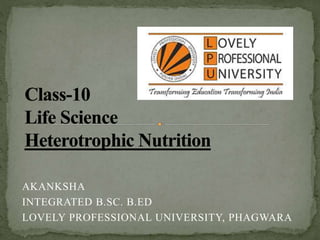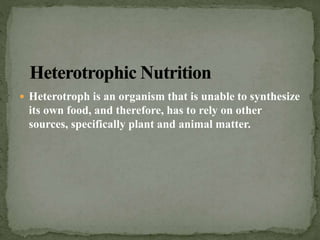Heterotrophic mode of nutrition
- 1. AKANKSHA INTEGRATED B.SC. B.ED LOVELY PROFESSIONAL UNIVERSITY, PHAGWARA
- 2. ’éŚ Heterotroph is an organism that is unable to synthesize its own food, and therefore, has to rely on other sources, specifically plant and animal matter.
- 3. 1. ŌĆó Holozoic 2. ŌĆó Saprophytic 3. ŌĆó Parasitic
- 4. ’éŚ Holozoic nutrition involves the ingestion and internal processing of solid and liquid food in an organism. This involves the steps of ingestion, digestion, absorption, assimilation and excretion. ’éŚ Examples of animals that exhibit holozoic nutrition include all vertebrates. Even some unicellular organisms such as amoeba also exhibit holozoic nutrition
- 6. ’éŚ Saprophytes (animals which follow saprophytic nutrition) feed on dead and decayed organisms for energy. They are an important part of the ecosystem as they help to keep our environment clean and recycle nutrient back into the ecosystem. ’éŚ Some examples of saprophytes are fungi and certain types of bacteria. These are also responsible for the staling of bread and other similar food products.
- 8. ’éŚ Organisms that live in or on other organisms and acquire food at the expense of its host are called parasites. ’éŚ Most parasites are harmful to the hostsŌĆÖ health; sometimes, they even kill the host. Both animals and plants may serve as a host. ’éŚ Examples of parasites are lice on a human head, Cuscuta plant and tapeworms.
- 10. ’éŚ Que-1. What do you understand by heterotrophic mode of nutrition? ’éŚ Que-2. What are the different types of heterotrophic nutrition? ’éŚ Que-3. What are the different types of Heterotrophs?









